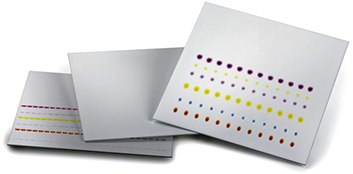TLC Plate Selection Guide
Thin layer chromatography (TLC), an analytical technique often used to separate and identify compounds present in a given mixture, can also be used to determine the purity of a particular substance within that mixture. TLC is ecomomical; hence it is often used for preliminary evaluations of separation parameters for column chromatography. Because of its simplicity and speed, TLC is also ideal for monitoring chemical reactions by qualitatively analyzing the reaction products. We offer a broad range of TLC products to address this wide variety of application needs. Here we describe various selection criteria that might be considered in choosing the ideal TLC plate for a particular application.

Plate Type
We offer a wide selection of standard analytical TLC plates. In addition to standard analytical TLC plates, Supelco offers a variety of both high performance and preparative TLC plates. High-performance Thin Layer Chromatography (HPTLC) plates are characterized by smaller particles, usually less than 10 µm, thinner layers, less than 200 µm and smaller plates with less than 10 cm developing distance. HPTLC offers distinct advantages over traditional TLC, which include better resolving power, faster development times, lower sample diffusion, and reduced solvent consumption. Like standard TLC plates, HPTLC plates are available coated with a variety of matrices and with or without indictors. Preparative TLC plates are used to purify or isolate a particular substance by separating it from contaminants. To allow them to separate larger quantities of material, these plates have adsorbent layer thicknesses of greater than 100 µm. They also typically have softer inorganic binders so sample bands can be removed more easily after separation.
Backing (Support) Types
Three types of backing are available for individual application requirements; glass, aluminum and plastic. Rigid, transparent and reusable, glass plates offer high chemical resistance and good heat stability for charring. For these reasons, they are the most widely used plate support. Aluminum foil plates are a support alternative that offers ease of handling and resistant to breakage. Lightweight and thinner than glass plates, aluminum plates can reduce shipping costs and save storage space. Additionally, they can be easily cut with scissors to the desired dimensions or stored in laboratory notebooks. Solvent resistance and compatibility with aqueous eluents are other features of aluminum plates which may be appealing for specific applications. Plastic or polyester (PET) plate supports are also lightweight and flexible. Like aluminum-backed plates, they can be cut to de
Adsorbent Layers/Matrices
Our glass, aluminum foil and PET (polyester) TLC plates are available coated with a variety of matrices and are available with or without fluorescent indicator.
Available matrices include:
- Silica gel (unmodified, modified/bonded, chiral, and high purity) – most common TLC sorbent. Eluents used are similar to those used for normal phase HPLC. Does not have the catalytic properties of alumina.
- Aluminum oxide – exhibits selectivity similar to, although slightly different than, silica. Second most common TLC sorbent.
- Cellulose – available as either microcrystalline or fibrous cellulose. Spots are generally more compact when separated on layers of microcrystalline cellulose than when separated on layers of fibrous cellulose.
- Polyamide – exhibits low diffusivity, allowing for tightly confined sample spots with maximum intensity. Corrosive visualization reagents are not recommended.
Binders
Plates are available with polymeric (organic) and inorganic binders. Binders do not generally impact the adsorptive properties of the matrix, but they do impact the adherence of the adsorbent layer to the backing.
Available binders include:
- Polymeric (organic) binders – plates with adsorbent layers containing polymeric binders are generally most rugged, making sample handling and application easier. They also permit the use of higher water content in the developing solvent. They are generally recommended for all TLC applications except for those that use charring for visualization.
- Inorganic binders – plates with adsorbent layers containing inorganic binders are not as rugged as those with organic binders but are generally more rugged than plates without a binder or with a gypsum binder. They are the most water resistant and compatible with aqueous developing reagents. Inorganic binders are often used for preparative TLC plates because they are soft, allowing for spots containing the target molecule to be easily scraped off the support for elution and recovery. Plates with inorganic binder are recommended for applications requiring charring for visualization, or when developing or visualization reagents interact with an organic binder.
- Gypsum – plates or that use a gypsum binder are generally least rugged and fracture easily. They are not recommended for use with developing solvents containing more than 20% water. Like plates with inorganic layers, they allow spots containing the target molecule to be easily scraped off the support for elution and recovery and are recommended for applications requiring charring for visualization.
Plate Dimensions
Choose from a comprehensive variety of plate dimensions:
- Larger plates (such as 20 cm x 20 cm plates) – often less costly as they can be cut into smaller sizes as needed.
- Pre-scoring (available on some of our glass plates) – makes cutting glass plates easier and safer as they can be easily snapped into smaller dimensions.
- Aluminum and plastic (PET)-backed – easy to cut to desired dimensions with a pair of scissors.
- Smaller, pre-cut plates – offer the advantages of convenience and ease of use that may make them the more practical choice in labs where productivity rather than per plate cost is the major driver.
To continue reading please sign in or create an account.
Don't Have An Account?